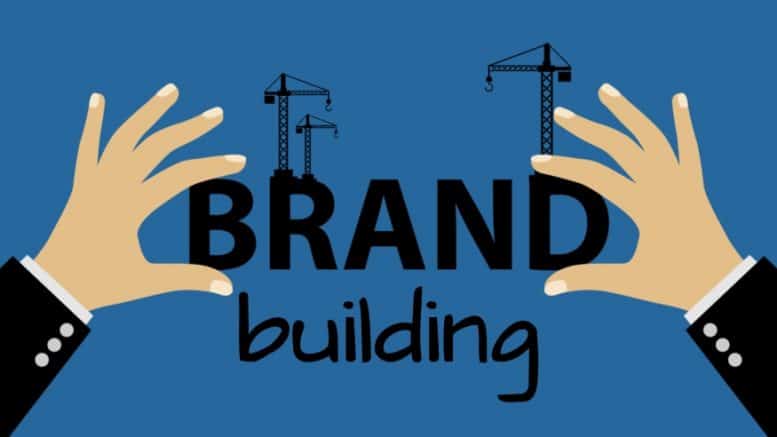Kubler-Ross change model: how do people react when you applying change
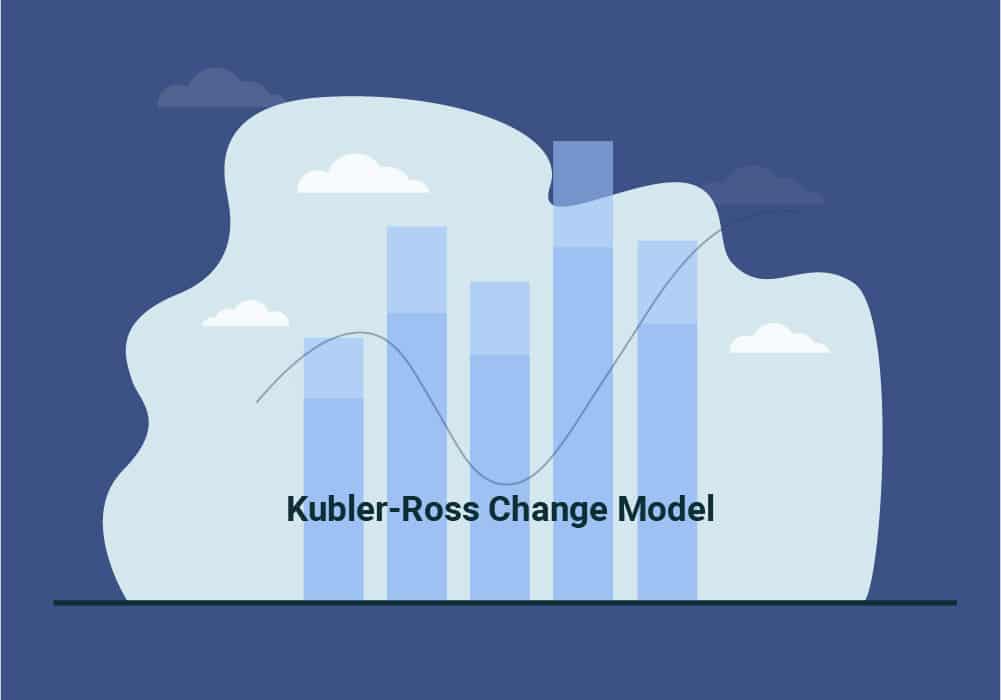
People react differently when they are forced to accept change. Despite a must thing, most of us are denying change or emotionally reluctant to accept life changes. We all know that change is an inevitable part of life and no one can run away from it. If change is well scheduled and framed, it can produce positive results but even despite preparation, change is hard to incorporate, receive and appreciate.
This post shall unveil the Kubler-Ross Change Curve that is the most reliable instrument to know change and the stages associated with it. The Kubler-Ross Change model can be effectively used by business professionals across the world to aid their workers adapt to change and move towards success. People react differently to the same manifestation that comes out from the external forces. Most of them are run away from changes because change itself is hard to accept. Knowing the effects of personal fine-tuning is critical to providing structure for employees experiencing this mayhem.
What is Kubler-Ross change Curve?
This change model was first introduced by Kubler-Ross, a Swiss-American psychologist in her famous work “On Death and Dying”. In this book, she had been described five stages of grief. These stages denote the usual range of feelings people experience when dealing with change in their lives – or in the place of work.
Change means “Loss”. When you are accepting a change, you are losing something from your current state. The “Five stages” model is used to understand how individuals react to change at different times. As the 5 stages of grief is a prototype involving various levels or stages of emotions that are encounter by a person who is soon going to approach death or is a survivor of close death.
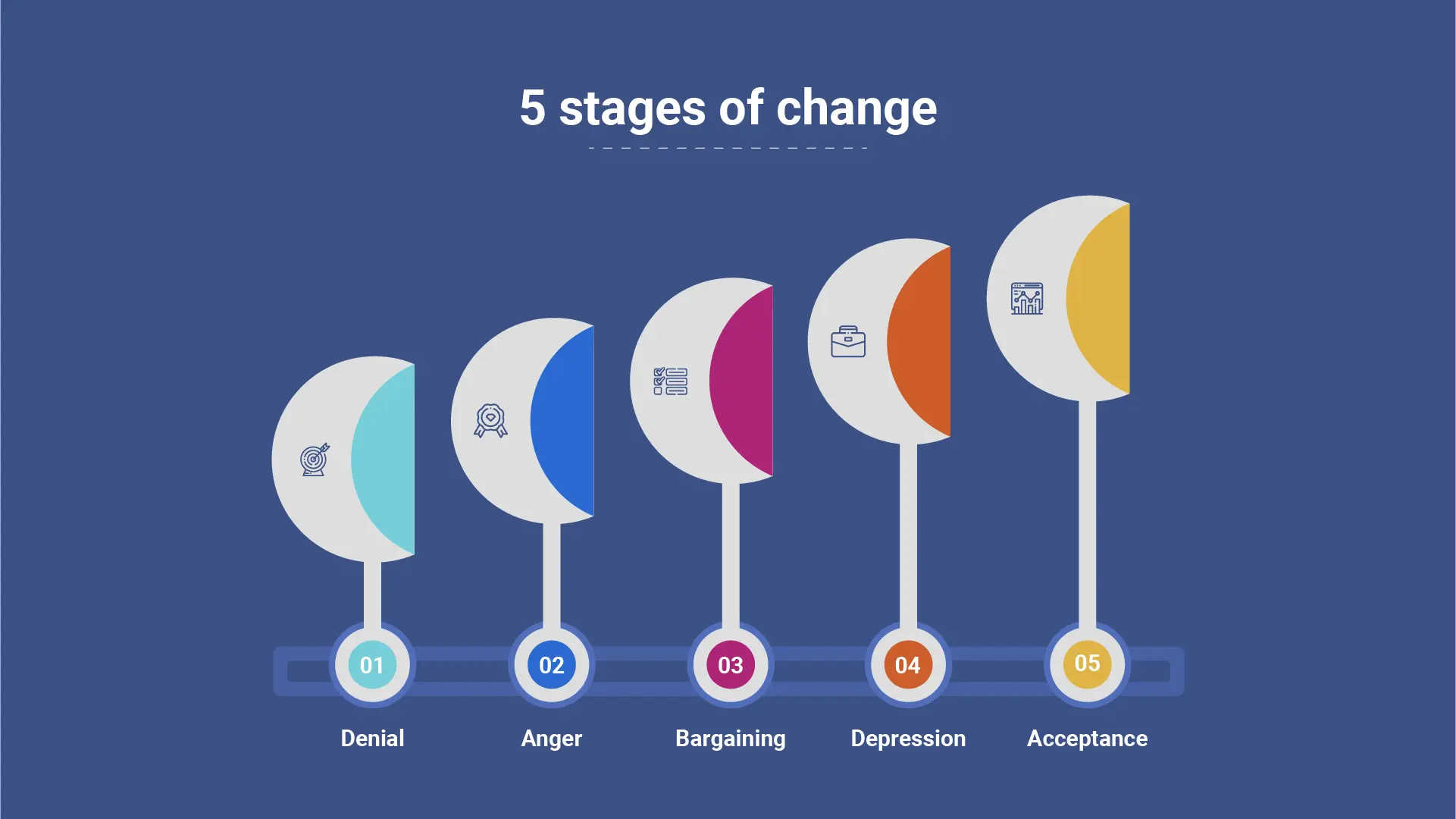
The 5 stages included in this model are denial, anger, bargaining, depression and acceptance. Kubler- Ross’s concept, as well as the model, was motivated by her association and work with patients who were critically ill. The psychiatrist Kubler-Ross got tending towards this subject because of lack of research and evidence on the subject of death and know-how of dying. She began her research by examining and assessing those who were faced with demise, but the analysis took the form of a series of meetings and then patient interviews, etc. later on.
Application of Kubler- Ross curve in the business context
The concept was widely accepted after the publication because it was found that the concept has relevance in many cases and situation relating to change. Business organizations also adapted this change model to understand how employees navigate to change. Managing change effectively denotes helping people and organizations shift from the ‘current state’ to the ‘future state’ in a way that reduces productivity losses, customer impact and employee turnover.
Every organization wants to bring about changes in its administration and plans. But further the upgrading of systems, there must be a change in the people or employees as well. If even in bringing about a number of changes in the systems and methods, the workers of your company continue in their old ways, and then the thousands of dollars financed will go to waste. This is why it is vital for the employees too to adjust, adapt, and change accordingly. The organization can reap the benefits only after the employees are ready to accept changes. However individual transformation could bring mindset losses and may cause traumatic conditions.
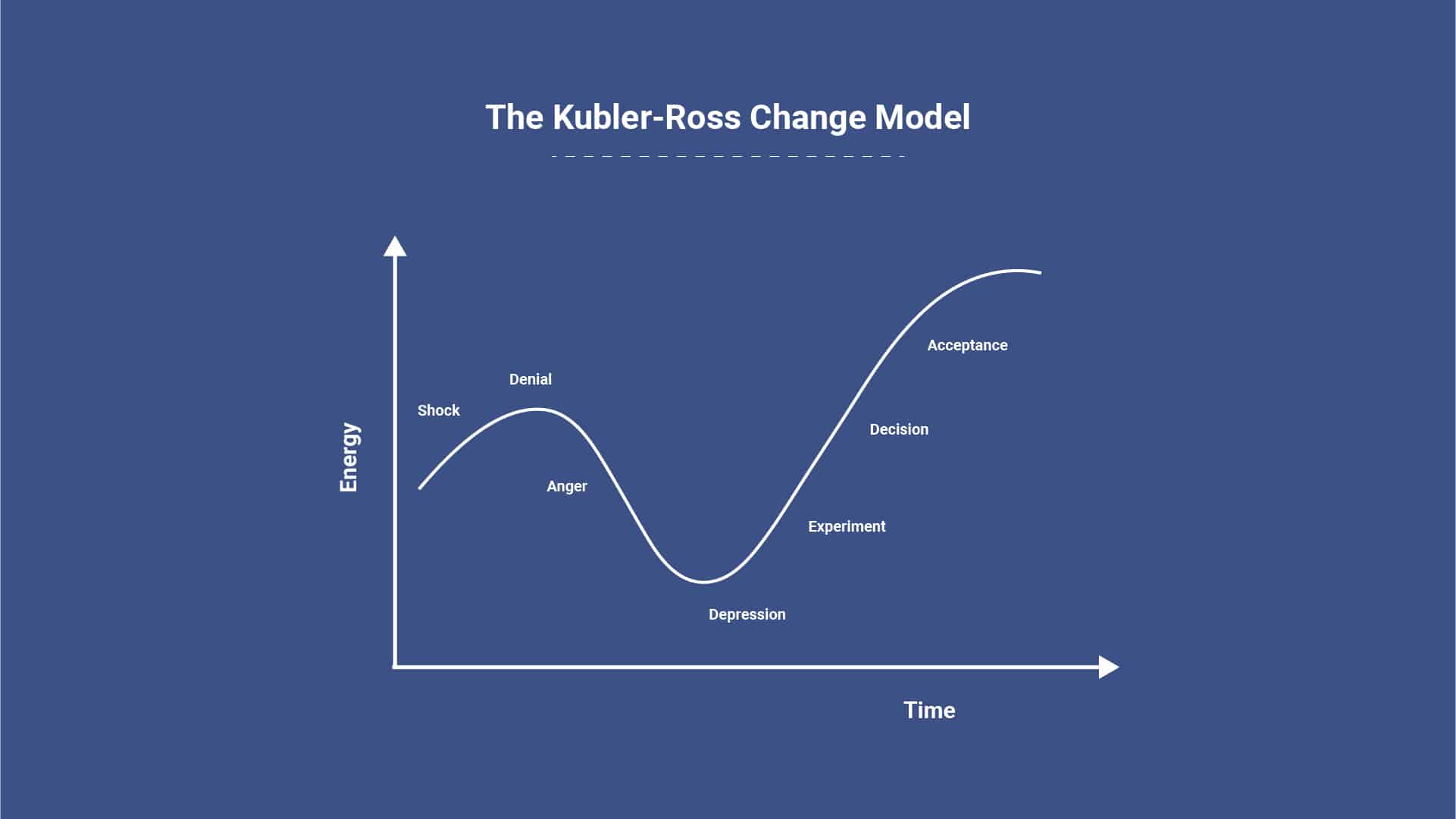
If the employees show easiness to adapt to changes, the organization could move towards success. Thus, this impacts the success rate and overall profits experienced by the company. The Change Curve in business is thus a dominant model that can help one comprehend and deal with changes and personal makeovers.
The regions on the change curve appear self-explanatory, but for change leaders, it is essential to understand each point on the turn. Knowing where persons and groups are in this process lets the management of change have greater effectiveness. The stages are detailed below.
Shock or denial
Denial is the first stage of shock. When hearing an unexpected thing normally people react with shock. This is a stage during which one puts on a temporary defense mechanism and takes time to process certain upsetting news or reality. One may not like to believe what is happening and that it is happening to him/her. It can bring about a drop in productivity and the capability to think and act. After the early shock lessens, one may experience denial and may continue to focus on the past. Some people have a habit of remaining in a state of denial for a long time and may lose touch with reality.
Denial is the reaction towards change. People would like to live in their current state so they don’t want to transform themselves. So, when an illness comes people often say “I can’t believe it”, “This can’t be happening”, “Not to me!”, “Not again!
Anger
After realizing change is real and will affect us it turns to anger. After getting anger the person will put blame on others and strongly believes that this is happening because of the interference of others. Anger can be showed or expressed in several ways. While some persons think all of the situations are because of them, some are blamed on others. While some may be angry at life overall, others may blame the economy. One always tends to remain sensitive, irritated, and short-tempered during this stage. The frustration becomes an obstacle to productivity.
The company administrators should sense the anger of staffs, the more you really feel, the more it will begin to dissolve and the more you will heal. This is the part of anger management from both management and staff sides. When change is happening people often say, “Why me? It’s not fair!” “NO! I can’t agree with this!”
Bargaining
Bargaining will happen after we understand “change is a must”. When the impending death comes, we make prayers to postpone it for just participate in the marriage of the daughter or something like that. Most of these bargains are stealthy deals with God, others, or life, where we say “If I assurance to do this, then you make the change not happen to me”. When the stage of anger passes away, one may start thinking about ways to delay the unavoidable and try to find out the best thing left in the situation. Those who are not faced with death but by another suffering may try to bargain in the situation and come to a point of compromise. Bargaining may help to come to a justifiable solution and might bring some relief to those who are moving close to what they wish to avoid altogether.
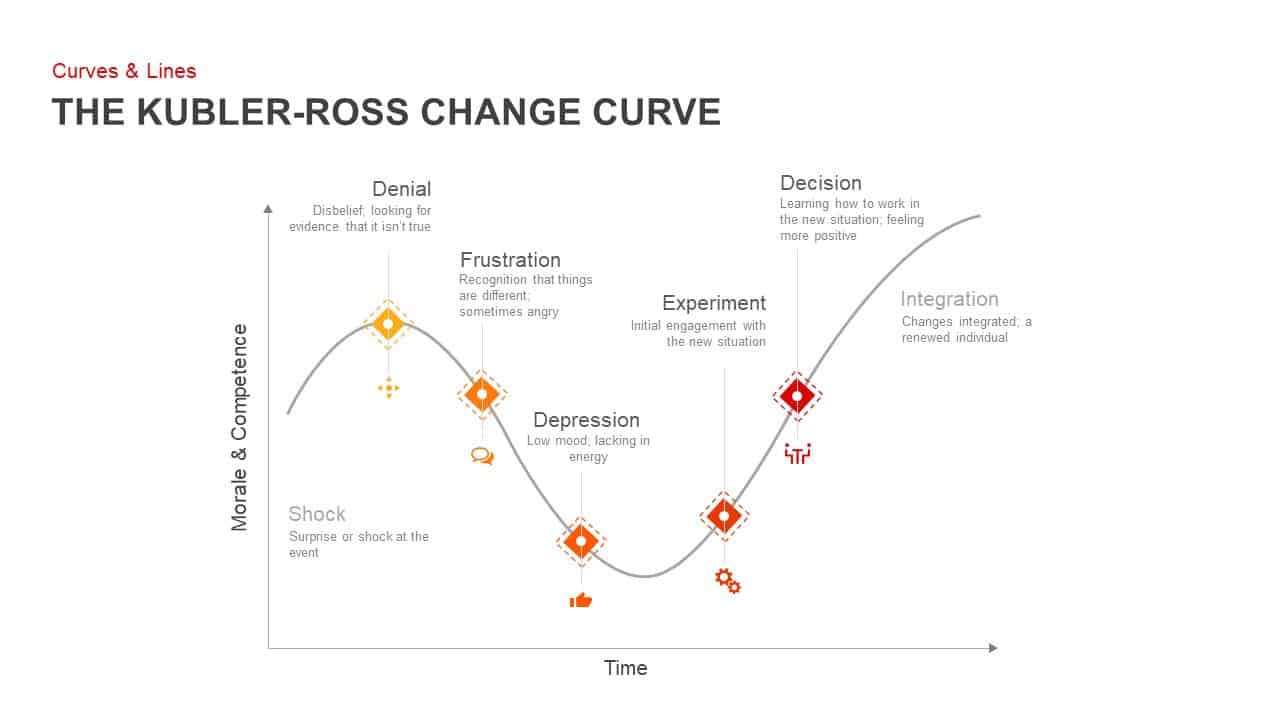
download Kubler-ross PowerPoint template
In business, individuals or teams try to delay or avoid changes that they think will hurt them. When death comes as inevitable, people often promise “I’ll do anything if you give me more time A few more years?”
Depression
When we understand that bargaining is not going to work the reality of the changesets in. At this point, we become aware of the fatalities associated with the change and what we have to leave behind. This has the possibility to move people towards a depressed state, feeling down and sad with low energy. One may display signs of nihilism, indifference, pushing others away and zero enthusiasm towards anything in life. This may seem like the lowest point in life with no way ahead. Some common signs of depression include grief, low energy, feeling discouraged, losing trust in God, and lost trust with even existing knowledge. At this stage, people often say “I’m so dejected, why bother with anything?”.
Acceptance
As people understand that combating the change is futile so they are ready to accept change. For the first time, people start considering their options. This can be a creative space as it forces people to discover and look for new opportunities. Sometimes they are ready to live by coping with grief or they ready to accept complete changes with a fresh outlook.
Acceptance is the last stage about accepting the reality that our loved one is actually gone and be familiar with the new reality is the permanent truth. The people within a company admit there is a new way of doing things and appreciate the significance of learning new methods and processes. At this stage, people often say “It’s going to be OK.”; “I can’t fight it, this is the time for preparation”
After experiencing loss, one must move to reality and showing compatibility with adapting to changes. otherwise, they may be always in a state of depression that may cause self-destruction. Kubler-ross change curve is based on pure psychological analysis. So it is applicable in both professional and personal levels of accepting changes.
